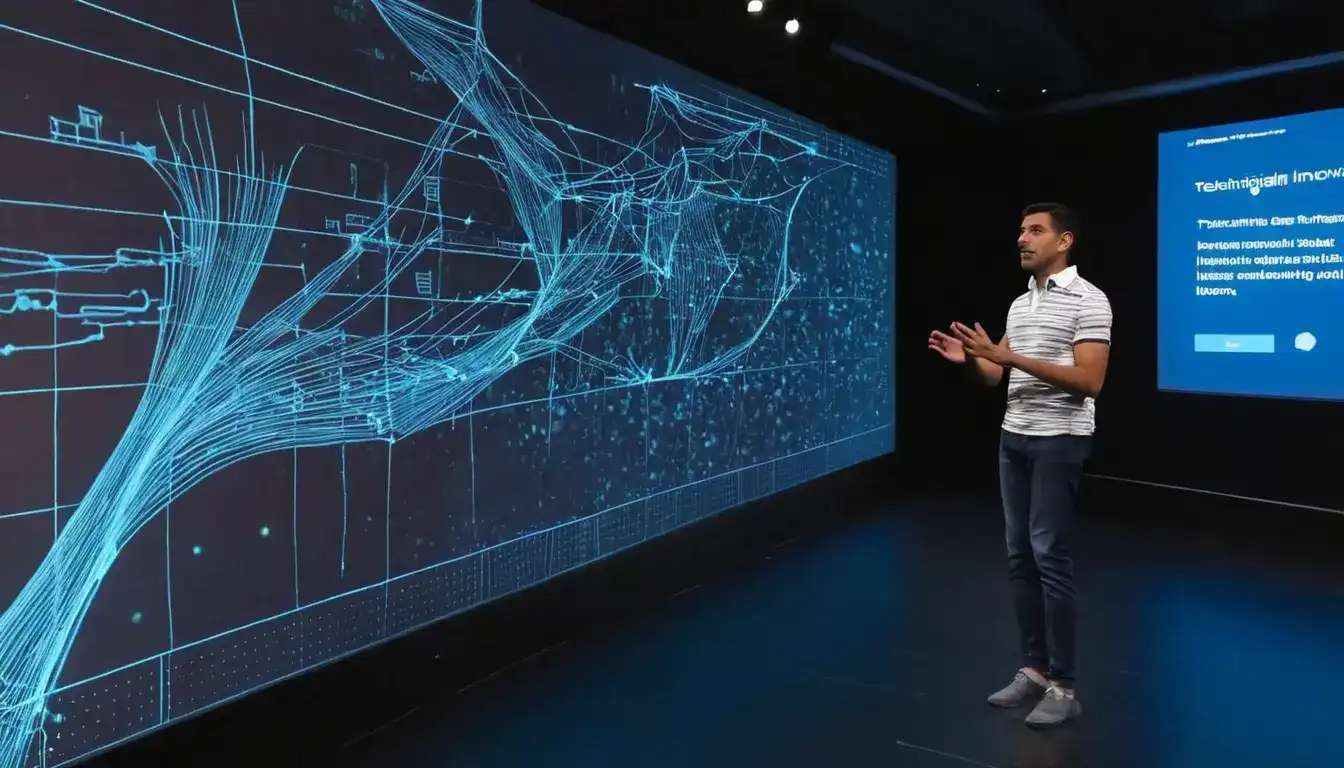Latest Trends in Mobile Application Development
Emily Willis

Photo: Latest Trends in Mobile Application Development
Mobile application development has been rapidly evolving, driven by technological advancements and changing user expectations. As we progress through 2024, several trends are shaping the landscape of mobile app development, influencing how developers create, deploy, and maintain applications. This article explores the latest trends in mobile application development, highlighting key innovations and their impact on the industry.
1. 5G Technology Integration
The advent of 5G technology is revolutionizing mobile app development by offering significantly faster network speeds and lower latency. This enables developers to create more complex and data-intensive applications that deliver seamless user experiences. 5G also facilitates the widespread adoption of technologies like Augmented Reality (AR), Virtual Reality (VR), and Internet of Things (IoT) in mobile apps.
2. Artificial Intelligence and Machine Learning
AI and Machine Learning (ML) are increasingly being integrated into mobile apps to enhance user interactions and provide personalized experiences. AI-powered chatbots, predictive analytics, and recommendation engines are becoming standard features in applications across various domains, from e-commerce to healthcare.
3. Internet of Things (IoT) Integration
The IoT ecosystem continues to expand, influencing mobile app development by enabling connectivity between devices and applications. IoT integration allows users to control smart devices remotely through mobile apps, monitor data in real-time, and automate tasks, enhancing convenience and efficiency.
4. Augmented Reality (AR) and Virtual Reality (VR)
AR and VR technologies are reshaping user engagement in mobile apps, particularly in gaming, retail, and education sectors. Developers are leveraging AR/VR to create immersive experiences, product visualizations, virtual tours, and interactive training modules, providing users with unique and engaging content.
5. Cross-Platform Development
Cross-platform frameworks like Flutter and React Native are gaining popularity among developers for building apps that run seamlessly on multiple platforms, including iOS and Android. These frameworks streamline development processes, reduce time-to-market, and offer cost-efficiency without compromising performance.
6. Mobile Wallets and Payment Gateways
The rise of mobile wallets and integrated payment gateways is transforming how users make transactions through mobile apps. Secure and convenient payment options, coupled with advanced encryption technologies, ensure safe financial transactions within applications, boosting user trust and engagement.
7. Progressive Web Apps (PWAs)
PWAs combine the features of web and mobile applications, offering users app-like experiences directly through web browsers. PWAs are lightweight, fast-loading, and responsive, making them ideal for delivering content and services across devices with minimal friction.
8. Enhanced App Security
With growing concerns over data privacy and cyber threats, app security has become paramount in mobile app development. Developers are implementing robust security measures, including end-to-end encryption, biometric authentication, and secure APIs, to protect user data and build trust.
9. Voice Search and Integration
Voice-enabled functionalities are becoming prevalent in mobile apps, allowing users to perform tasks, search queries, and control applications using voice commands. Voice integration enhances accessibility and user convenience, catering to a broader audience base, including those with disabilities.
10. Sustainability and Green Mobile Apps
There is a rising trend towards developing sustainable and eco-friendly mobile applications that minimize carbon footprints and promote environmental conservation. Developers are focusing on optimizing app performance, reducing energy consumption, and adopting eco-conscious design principles.
Conclusion
In conclusion, the landscape of mobile application development is evolving rapidly, driven by technological innovations and shifting user preferences. The adoption of 5G technology, integration of AI/ML, IoT connectivity, and advancements in AR/VR are reshaping how mobile apps are developed and experienced. Cross-platform development, enhanced security measures, and the rise of PWAs are also influencing the industry's trajectory. As mobile devices continue to proliferate globally, staying updated with these trends is crucial for developers and businesses aiming to deliver cutting-edge mobile experiences. By embracing these trends, developers can create innovative, user-centric applications that set new standards in the mobile app ecosystem.
Latest ✨
View Allpractical tips for fostering a love of learning in children. It emphasizes the importance of understanding and catering to diverse learning styles, making learning relevant and engaging, fostering a growth mindset, creating a supportive learning environment, and extending the love of learning beyond the classroom.
Emily Willis
Uncover the best AR translation apps on the market through our in-depth testing and reviews. From seamless voice conversations to real-world text translation, these apps will revolutionize the way you communicate across languages.
Emily Willis
Edge computing is a distributed computing model that processes data closer to its source, reducing latency, saving bandwidth, and enhancing security. It is transforming industries such as manufacturing, healthcare, retail, transportation, and energy by enabling real-time data processing and improving operational efficiency.
Emily Willis
the rise of eSports as a global phenomenon, highlighting its evolution from niche to mainstream, the impact of pioneering games and genres, the rise of professionalism, global appeal and audience engagement, cultural impact and integration, and bridging virtual sports and physical sports.
Emily Willis
Business
View All
August 5, 2024
Tips for Creating a Positive and Productive Work CultureCreating a positive and productive work culture is essential for the success of any organization. It requires continuous effort and dedication. The importance of work culture is highlighted, and tips for creating a positive work culture are provided, including planning social outings, maintaining clear expectations, creating listening posts, building psychological safety, watching trends, leading by example, fostering open communication, recognizing and rewarding employees, emphasizing work-life balance, celebrating milestones, providing opportunities for growth and development, and conducting regular feedback sessions.
Emily Willis

August 5, 2024
Apps and Tools that Can Help You Boost Productivityproductivity in today's fast-paced world and highlights various apps and tools that can help individuals stay organized, efficient, and focused. It covers categories such as task management, time tracking, note-taking, communication, password management, automation, email management, project management, focus enhancement, and calendar scheduling.
Emily Willis

August 5, 2024
How to Manage Time EffectivelyEffective time management is crucial for success in all areas of life. By mastering time management, you can boost productivity, reduce stress, and achieve a healthier work-life balance. This guide explores practical tips and techniques to help you take control of your schedule, enhance focus, and maximize your potential.
Emily Willis
Economy
View Allrecent surge in inflation globally, leading to rising prices of goods and services and impacting people's purchasing power and economic stability.
Read MoreIn today's rapidly changing economic landscape, innovation and resilience are more important than ever. Innovation drives progress and competitiveness by creating new ideas and solutions to meet market needs. Resilience helps businesses withstand shocks and bounce back from setbacks by planning strategically and diversifying resources.
Read MoreThe digital economy is rapidly changing the job market, with trends such as remote work, the gig economy, automation, e-commerce, cybersecurity, digital skills, and changes in traditional industries having significant implications. These trends offer both opportunities and challenges, requiring individuals and organizations to adapt by embracing flexibility, investing in continuous learning, and staying abreast of technological advancements in order to thrive in this evolving landscape.
Read MoreEntertainment
View All
August 4, 2024
Social Media's Influence on Celebrity Culture: Trends and ImpactsSocial media has revolutionized celebrity culture by enabling direct fan engagement, promoting authenticity, and creating new trends such as influencer marketing and digital content creation.
Emily Willis

August 5, 2024
VR and AR Transform EntertainmentVirtual reality (VR) and augmented reality (AR) are transforming the entertainment industry by offering immersive experiences that blur the lines between the real and virtual worlds. VR completely transports users into computer-generated environments, while AR overlays digital elements onto the real world.
Emily Willis

August 5, 2024
Entertainment in Society: Social Impact, Cultural Influence, Economic ContributionsEntertainment is more than just a way to pass the time it has a significant impact on society, culture, and the economy. It promotes empathy, sparks conversations, and drives social change. It reflects and shapes cultural trends, while also preserving traditions. The entertainment industry generates jobs, contributes to economic growth, and drives technological innovation.
Emily Willis
Health
View Allmaintaining good health and well-being through nutritional choices. A balanced diet, incorporating whole foods, staying hydrated, consuming nutrient-dense foods, managing portion sizes, practicing mindful eating, eating regular meals and snacks, considering supplements, and adopting sustainable eating practices are all highlighted as effective strategies for enhancing overall.
Emily Willis
Heart disease is a leading cause of death globally, but early detection and prevention strategies can reduce its impact. This article discusses the importance of early detection, common risk factors, preventive measures, and lifestyle changes for heart health. Understanding heart disease, recognizing symptoms, and undergoing regular screenings are crucial. Common risk factors include high blood pressure, high cholesterol, diabetes, smoking, obesity, physical inactivity, and family history. Symptoms of heart disease include chest pain, shortness of breath, fatigue, irregular heartbeat, and swelling. Diagnostic tests and screenings include blood pressure measurement, cholesterol screening, blood glucose test, ECG, stress test, and imaging tests. Preventive measures include adopting a heart-healthy diet, regular physical activity, quitting smoking, managing stress, maintaining a healthy weight, and limiting alcohol consumption. Medications and treatment options may be necessary for individuals at high risk or diagnosed with heart disease.
Emily Willis
cultivating healthy lifestyle habits to improve overall well-being. It focuses on three pillars of well-being: nutrition, exercise, and sleep. It provides tips on how to incorporate these practices into daily routines, such as eating a variety of foods, finding enjoyable forms of exercise, and establishing a consistent sleep schedule.
Emily Willis
Trending 🔥
View All
2
3
4
5
7
8
9
10
Sports
View AllAugust 4, 2024
Sports Technology Innovation: Revolutionizing Training and Performance Analysis
Read MoreTechnology
View All
August 5, 2024
Types of Cloud Computing Services Available
Cloud computing has become essential for modern businesses, offering services that streamline processes, reduce costs, and increase flexibility. Understanding the types of cloud computing services available, such as Infrastructure as a Service (IaaS), Platform as a Service (PaaS), and Software as a Service (SaaS), can help businesses make informed decisions.

August 5, 2024
The Future of Cybersecurity and Upcoming Challenges
cybersecurity in the digital age, highlighting key trends and challenges that will shape the future of cybersecurity. It addresses issues such as the increased use of AI and ML, the growth of IoT devices, ransomware attacks, cloud security, and supply chain attacks. It also outlines upcoming challenges in cybersecurity, including talent shortage, regulatory compliance, cybersecurity for remote work, quantum computing, and social engineering attacks.

August 5, 2024
Challenges and Opportunities in Implementing IoT Technology
The Internet of Things (IoT) is revolutionizing industries by enabling real-time monitoring, automation, and decision-making. However, implementing IoT technology comes with challenges such as security concerns, interoperability issues, data management, scalability, and cost. Despite these challenges, IoT offers opportunities for operational efficiency, enhanced customer experience, innovation, environmental sustainability, and business intelligence.

August 5, 2024
The Most Common Types of Cybersecurity Threats
In today's digital age, cybersecurity threats are increasing in sophistication and frequency. It is important for businesses and individuals to be aware of these threats in order to protect sensitive information and maintain privacy. Understanding common types of cybersecurity threats is the first step in safeguarding against them.





















